FORD F650 2006 11.G Owners Manual
Manufacturer: FORD, Model Year: 2006, Model line: F650, Model: FORD F650 2006 11.GPages: 272, PDF Size: 1.86 MB
Page 211 of 272
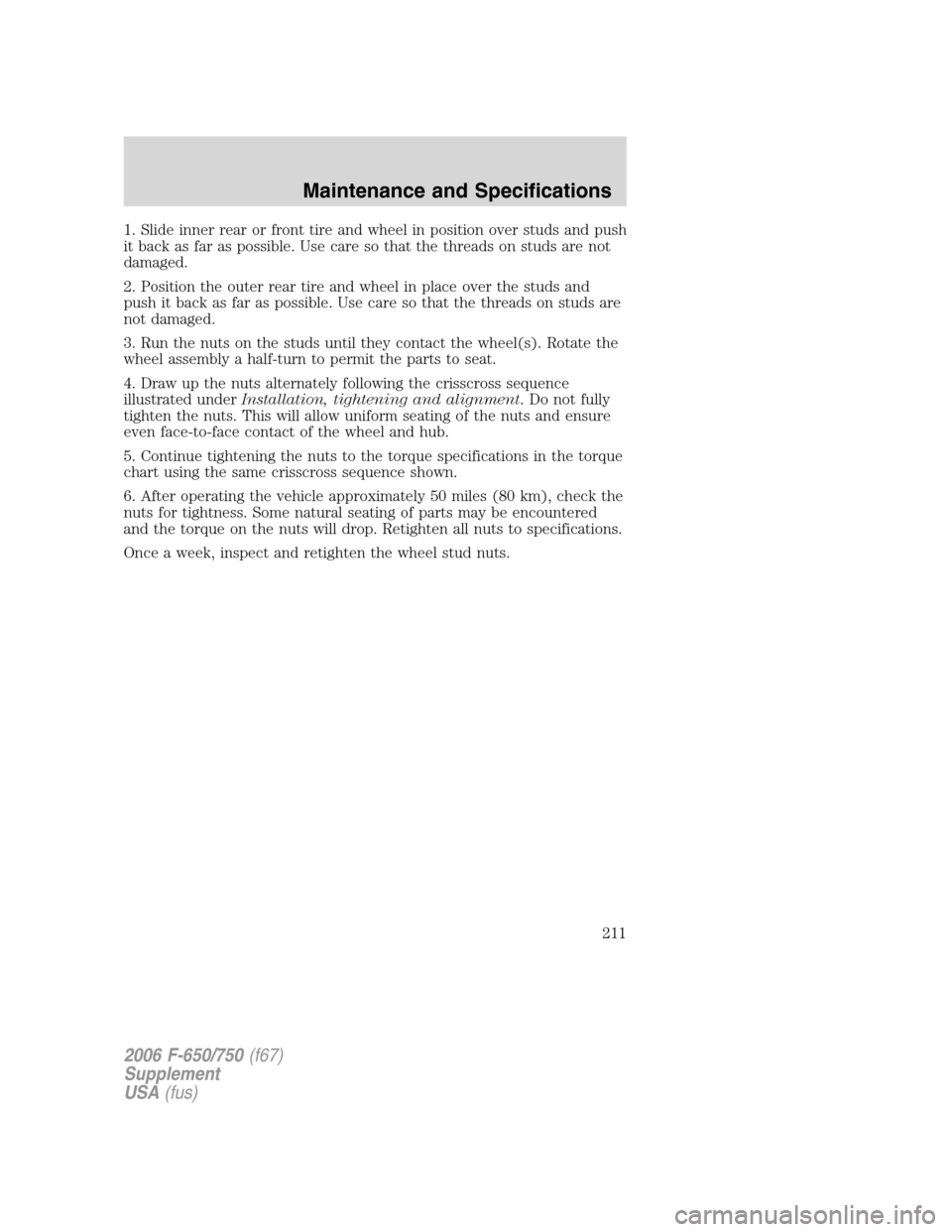
1. Slide inner rear or front tire and wheel in position over studs and push
it back as far as possible. Use care so that the threads on studs are not
damaged.
2. Position the outer rear tire and wheel in place over the studs and
push it back as far as possible. Use care so that the threads on studs are
not damaged.
3. Run the nuts on the studs until they contact the wheel(s). Rotate the
wheel assembly a half-turn to permit the parts to seat.
4. Draw up the nuts alternately following the crisscross sequence
illustrated underInstallation, tightening and alignment. Do not fully
tighten the nuts. This will allow uniform seating of the nuts and ensure
even face-to-face contact of the wheel and hub.
5. Continue tightening the nuts to the torque specifications in the torque
chart using the same crisscross sequence shown.
6. After operating the vehicle approximately 50 miles (80 km), check the
nuts for tightness. Some natural seating of parts may be encountered
and the torque on the nuts will drop. Retighten all nuts to specifications.
Once a week, inspect and retighten the wheel stud nuts.
2006 F-650/750(f67)
Supplement
USA(fus)
Maintenance and Specifications
211
Page 212 of 272
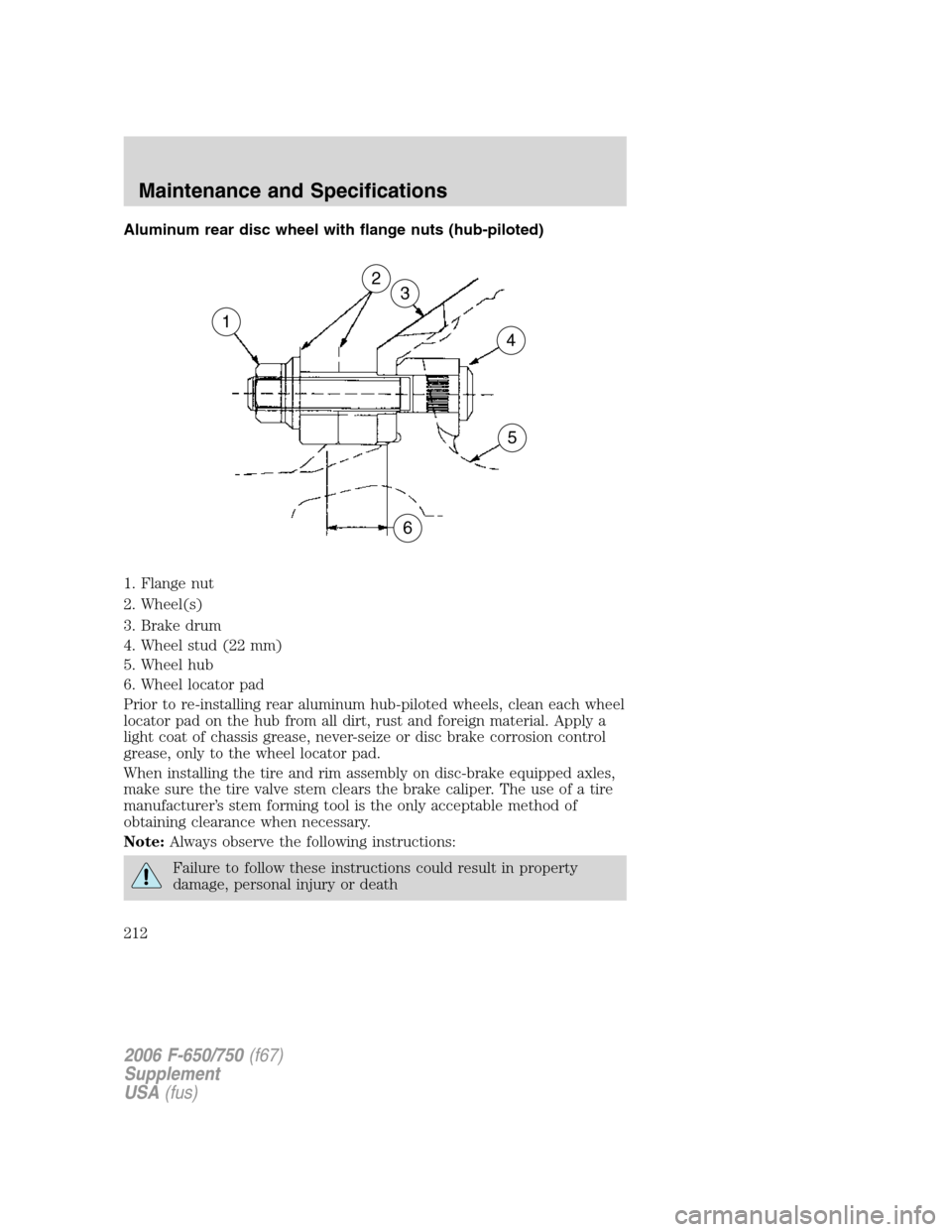
Aluminum rear disc wheel with flange nuts (hub-piloted)
1. Flange nut
2. Wheel(s)
3. Brake drum
4. Wheel stud (22 mm)
5. Wheel hub
6. Wheel locator pad
Prior to re-installing rear aluminum hub-piloted wheels, clean each wheel
locator pad on the hub from all dirt, rust and foreign material. Apply a
light coat of chassis grease, never-seize or disc brake corrosion control
grease, only to the wheel locator pad.
When installing the tire and rim assembly on disc-brake equipped axles,
make sure the tire valve stem clears the brake caliper. The use of a tire
manufacturer’s stem forming tool is the only acceptable method of
obtaining clearance when necessary.
Note:Always observe the following instructions:
Failure to follow these instructions could result in property
damage, personal injury or death
1
6
5
4
32
2006 F-650/750(f67)
Supplement
USA(fus)
Maintenance and Specifications
212
Page 213 of 272
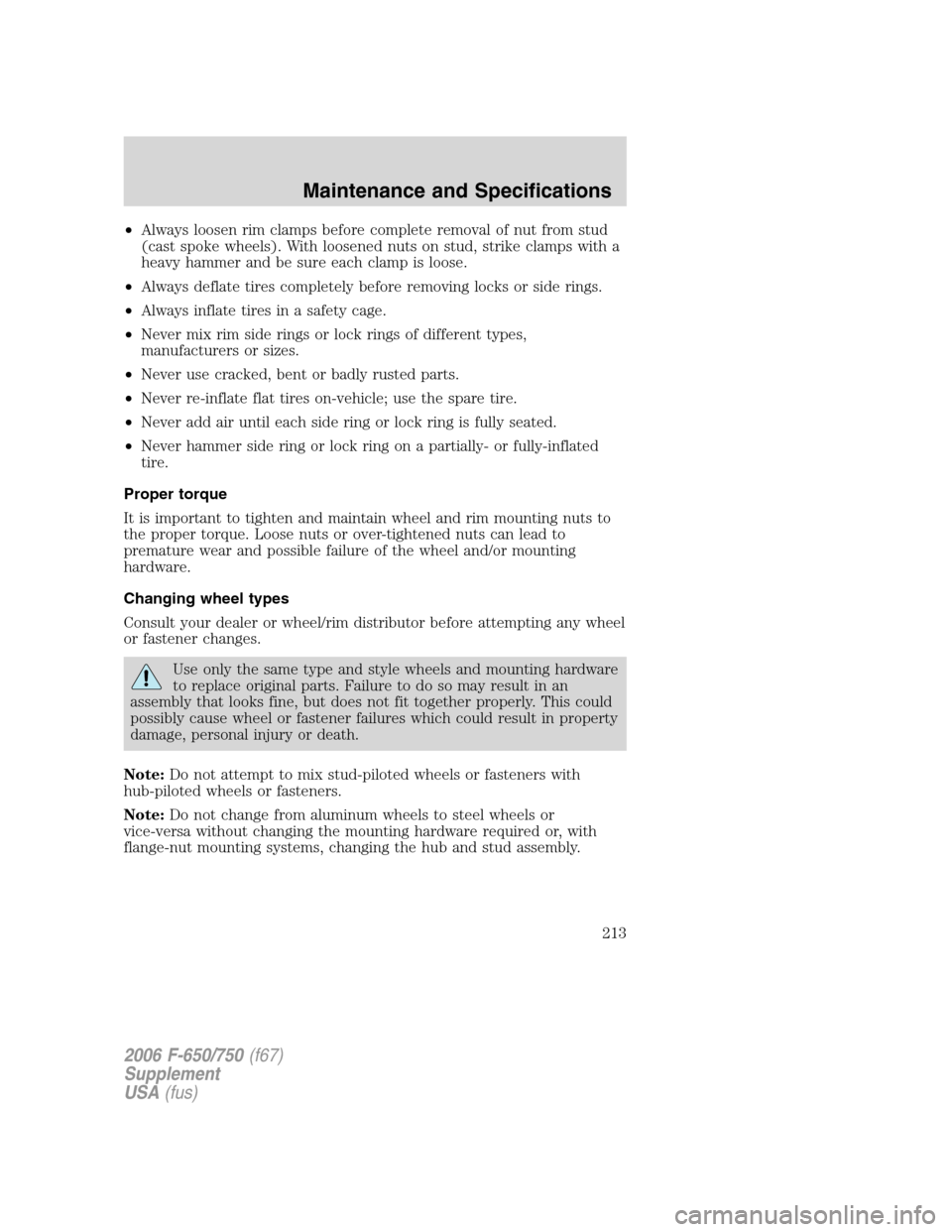
•Always loosen rim clamps before complete removal of nut from stud
(cast spoke wheels). With loosened nuts on stud, strike clamps with a
heavy hammer and be sure each clamp is loose.
•Always deflate tires completely before removing locks or side rings.
•Always inflate tires in a safety cage.
•Never mix rim side rings or lock rings of different types,
manufacturers or sizes.
•Never use cracked, bent or badly rusted parts.
•Never re-inflate flat tires on-vehicle; use the spare tire.
•Never add air until each side ring or lock ring is fully seated.
•Never hammer side ring or lock ring on a partially- or fully-inflated
tire.
Proper torque
It is important to tighten and maintain wheel and rim mounting nuts to
the proper torque. Loose nuts or over-tightened nuts can lead to
premature wear and possible failure of the wheel and/or mounting
hardware.
Changing wheel types
Consult your dealer or wheel/rim distributor before attempting any wheel
or fastener changes.
Use only the same type and style wheels and mounting hardware
to replace original parts. Failure to do so may result in an
assembly that looks fine, but does not fit together properly. This could
possibly cause wheel or fastener failures which could result in property
damage, personal injury or death.
Note:Do not attempt to mix stud-piloted wheels or fasteners with
hub-piloted wheels or fasteners.
Note:Do not change from aluminum wheels to steel wheels or
vice-versa without changing the mounting hardware required or, with
flange-nut mounting systems, changing the hub and stud assembly.
2006 F-650/750(f67)
Supplement
USA(fus)
Maintenance and Specifications
213
Page 214 of 272
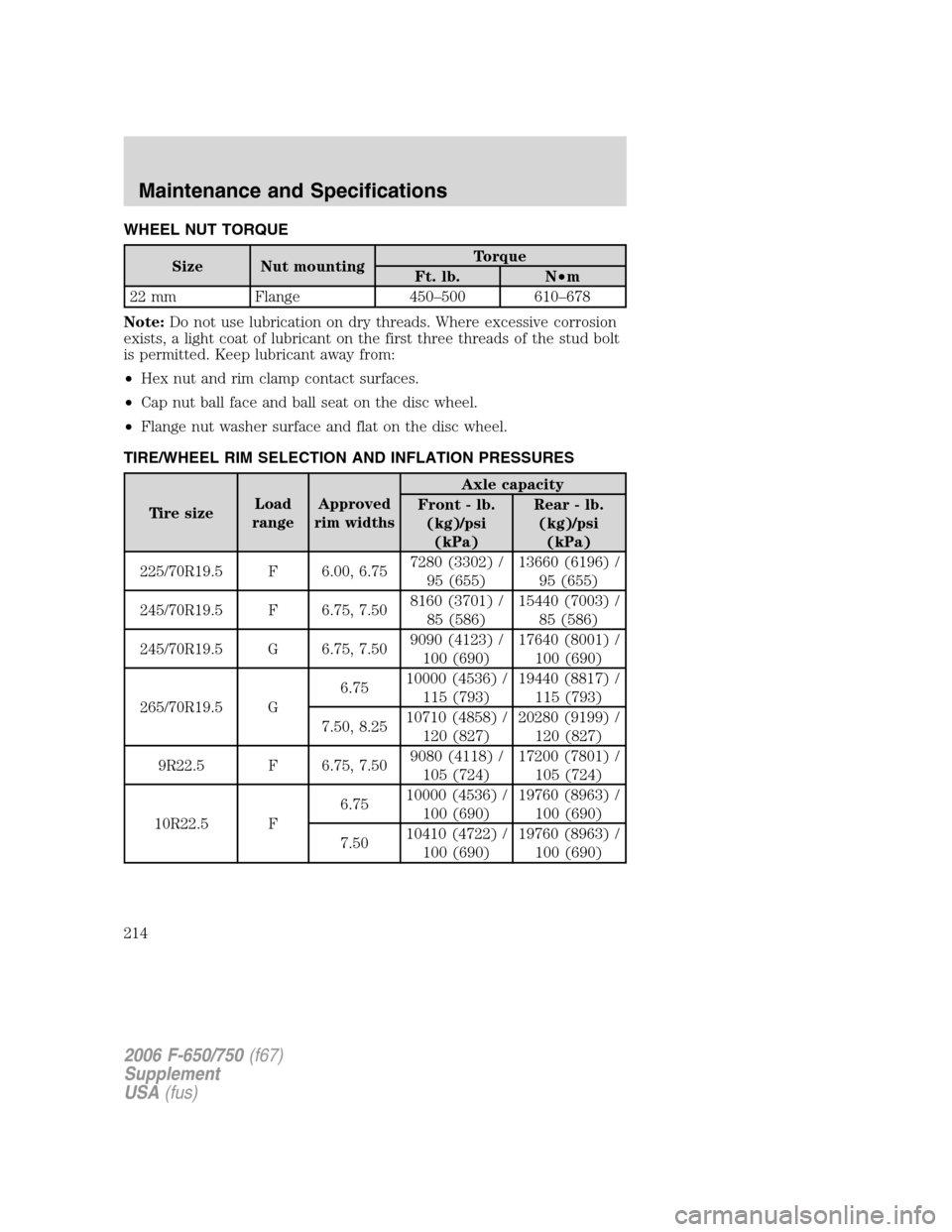
WHEEL NUT TORQUE
Size Nut mountingTorque
Ft. lb. N•m
22 mm Flange 450–500 610–678
Note:Do not use lubrication on dry threads. Where excessive corrosion
exists, a light coat of lubricant on the first three threads of the stud bolt
is permitted. Keep lubricant away from:
•Hex nut and rim clamp contact surfaces.
•Cap nut ball face and ball seat on the disc wheel.
•Flange nut washer surface and flat on the disc wheel.
TIRE/WHEEL RIM SELECTION AND INFLATION PRESSURES
Tire sizeLoad
rangeApproved
rim widthsAxle capacity
Front - lb.
(kg)/psi
(kPa)Rear - lb.
(kg)/psi
(kPa)
225/70R19.5 F 6.00, 6.757280 (3302) /
95 (655)13660 (6196) /
95 (655)
245/70R19.5 F 6.75, 7.508160 (3701) /
85 (586)15440 (7003) /
85 (586)
245/70R19.5 G 6.75, 7.509090 (4123) /
100 (690)17640 (8001) /
100 (690)
265/70R19.5 G6.7510000 (4536) /
115 (793)19440 (8817) /
115 (793)
7.50, 8.2510710 (4858) /
120 (827)20280 (9199) /
120 (827)
9R22.5 F 6.75, 7.509080 (4118) /
105 (724)17200 (7801) /
105 (724)
10R22.5 F6.7510000 (4536) /
100 (690)19760 (8963) /
100 (690)
7.5010410 (4722) /
100 (690)19760 (8963) /
100 (690)
2006 F-650/750(f67)
Supplement
USA(fus)
Maintenance and Specifications
214
Page 215 of 272
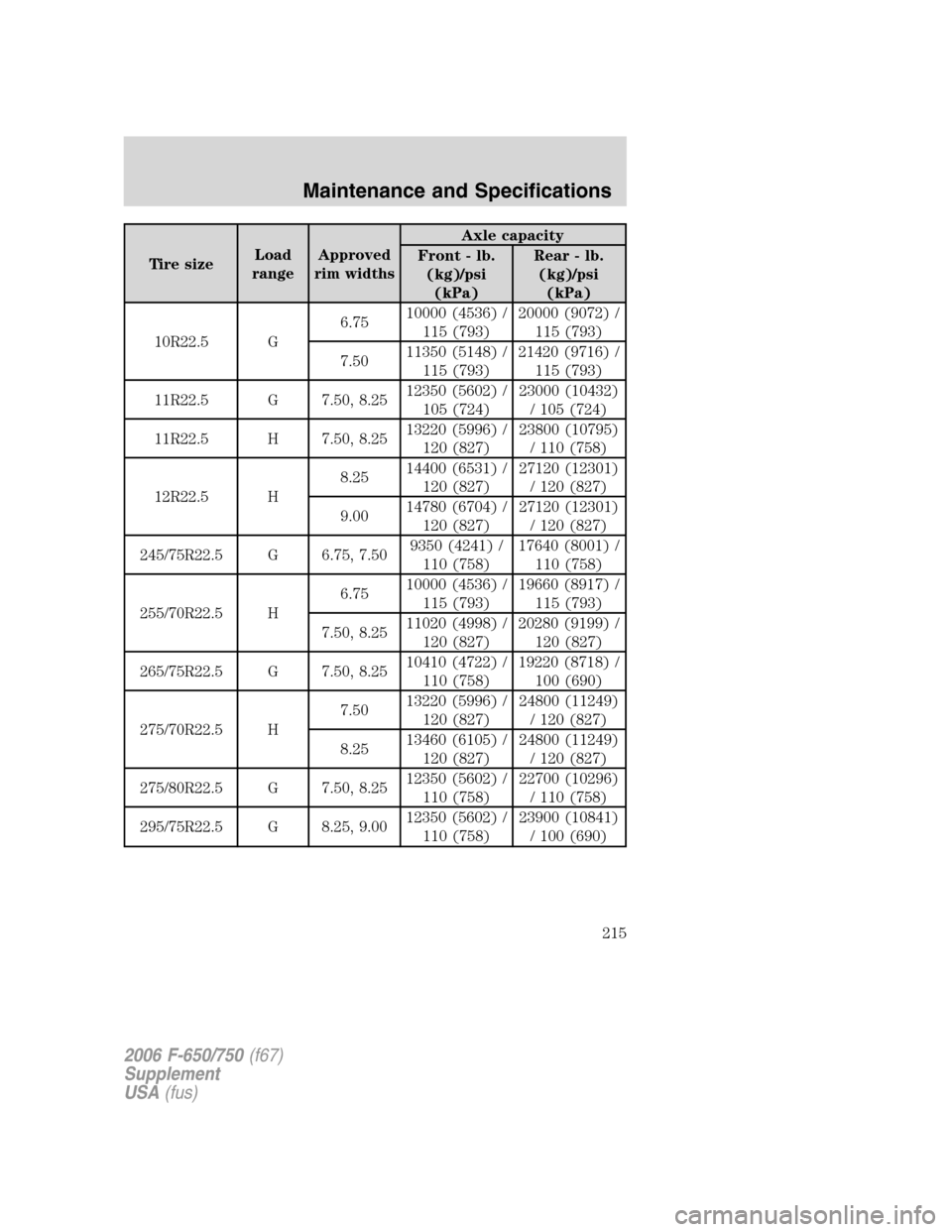
Tire sizeLoad
rangeApproved
rim widthsAxle capacity
Front - lb.
(kg)/psi
(kPa)Rear - lb.
(kg)/psi
(kPa)
10R22.5 G6.7510000 (4536) /
115 (793)20000 (9072) /
115 (793)
7.5011350 (5148) /
115 (793)21420 (9716) /
115 (793)
11R22.5 G 7.50, 8.2512350 (5602) /
105 (724)23000 (10432)
/ 105 (724)
11R22.5 H 7.50, 8.2513220 (5996) /
120 (827)23800 (10795)
/ 110 (758)
12R22.5 H8.2514400 (6531) /
120 (827)27120 (12301)
/ 120 (827)
9.0014780 (6704) /
120 (827)27120 (12301)
/ 120 (827)
245/75R22.5 G 6.75, 7.509350 (4241) /
110 (758)17640 (8001) /
110 (758)
255/70R22.5 H6.7510000 (4536) /
115 (793)19660 (8917) /
115 (793)
7.50, 8.2511020 (4998) /
120 (827)20280 (9199) /
120 (827)
265/75R22.5 G 7.50, 8.2510410 (4722) /
110 (758)19220 (8718) /
100 (690)
275/70R22.5 H7.5013220 (5996) /
120 (827)24800 (11249)
/ 120 (827)
8.2513460 (6105) /
120 (827)24800 (11249)
/ 120 (827)
275/80R22.5 G 7.50, 8.2512350 (5602) /
110 (758)22700 (10296)
/ 110 (758)
295/75R22.5 G 8.25, 9.0012350 (5602) /
110 (758)23900 (10841)
/ 100 (690)
2006 F-650/750(f67)
Supplement
USA(fus)
Maintenance and Specifications
215
Page 216 of 272
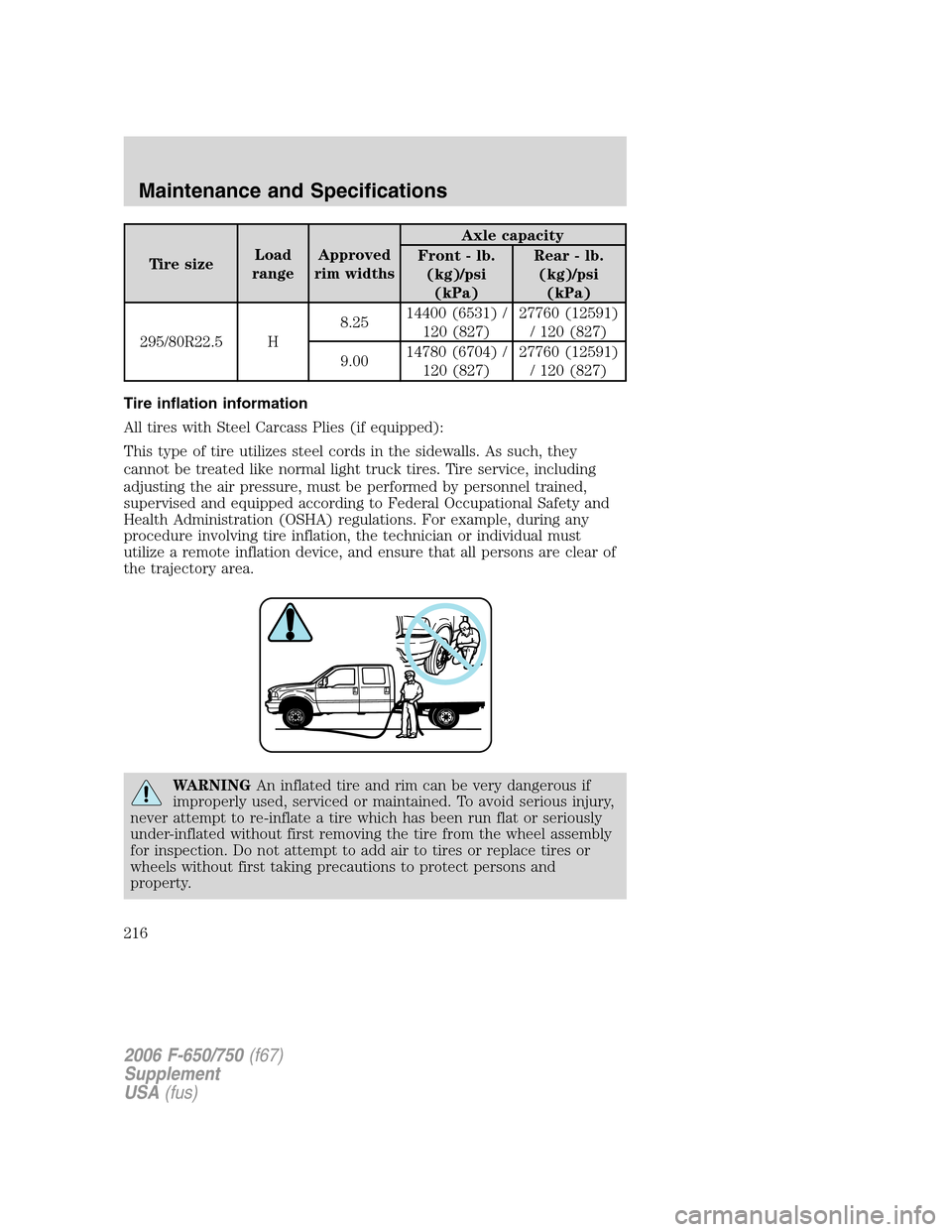
Tire sizeLoad
rangeApproved
rim widthsAxle capacity
Front - lb.
(kg)/psi
(kPa)Rear - lb.
(kg)/psi
(kPa)
295/80R22.5 H8.2514400 (6531) /
120 (827)27760 (12591)
/ 120 (827)
9.0014780 (6704) /
120 (827)27760 (12591)
/ 120 (827)
Tire inflation information
All tires with Steel Carcass Plies (if equipped):
This type of tire utilizes steel cords in the sidewalls. As such, they
cannot be treated like normal light truck tires. Tire service, including
adjusting the air pressure, must be performed by personnel trained,
supervised and equipped according to Federal Occupational Safety and
Health Administration (OSHA) regulations. For example, during any
procedure involving tire inflation, the technician or individual must
utilize a remote inflation device, and ensure that all persons are clear of
the trajectory area.
WARNINGAn inflated tire and rim can be very dangerous if
improperly used, serviced or maintained. To avoid serious injury,
never attempt to re-inflate a tire which has been run flat or seriously
under-inflated without first removing the tire from the wheel assembly
for inspection. Do not attempt to add air to tires or replace tires or
wheels without first taking precautions to protect persons and
property.
2006 F-650/750(f67)
Supplement
USA(fus)
Maintenance and Specifications
216
Page 217 of 272
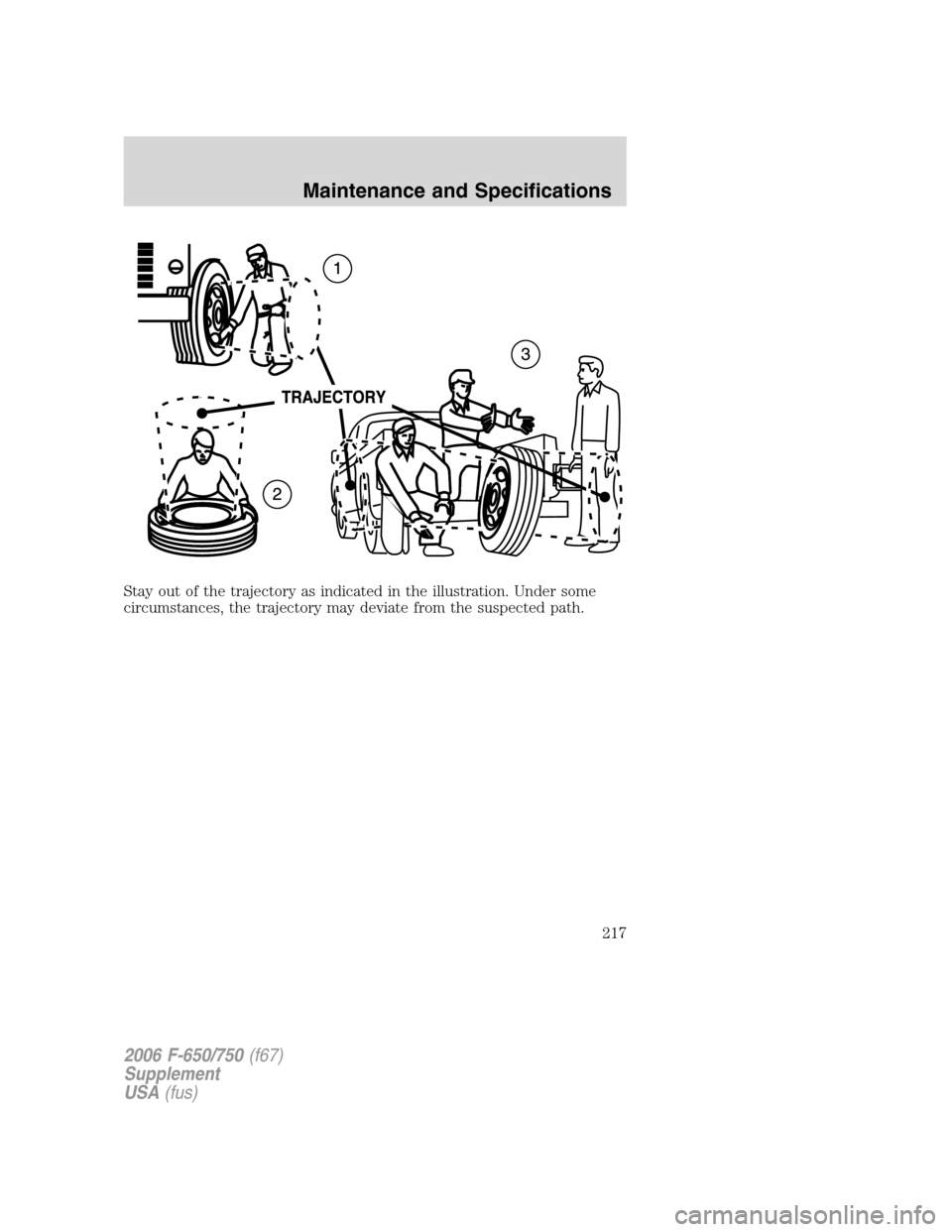
Stay out of the trajectory as indicated in the illustration. Under some
circumstances, the trajectory may deviate from the suspected path.
2006 F-650/750(f67)
Supplement
USA(fus)
Maintenance and Specifications
217
Page 218 of 272
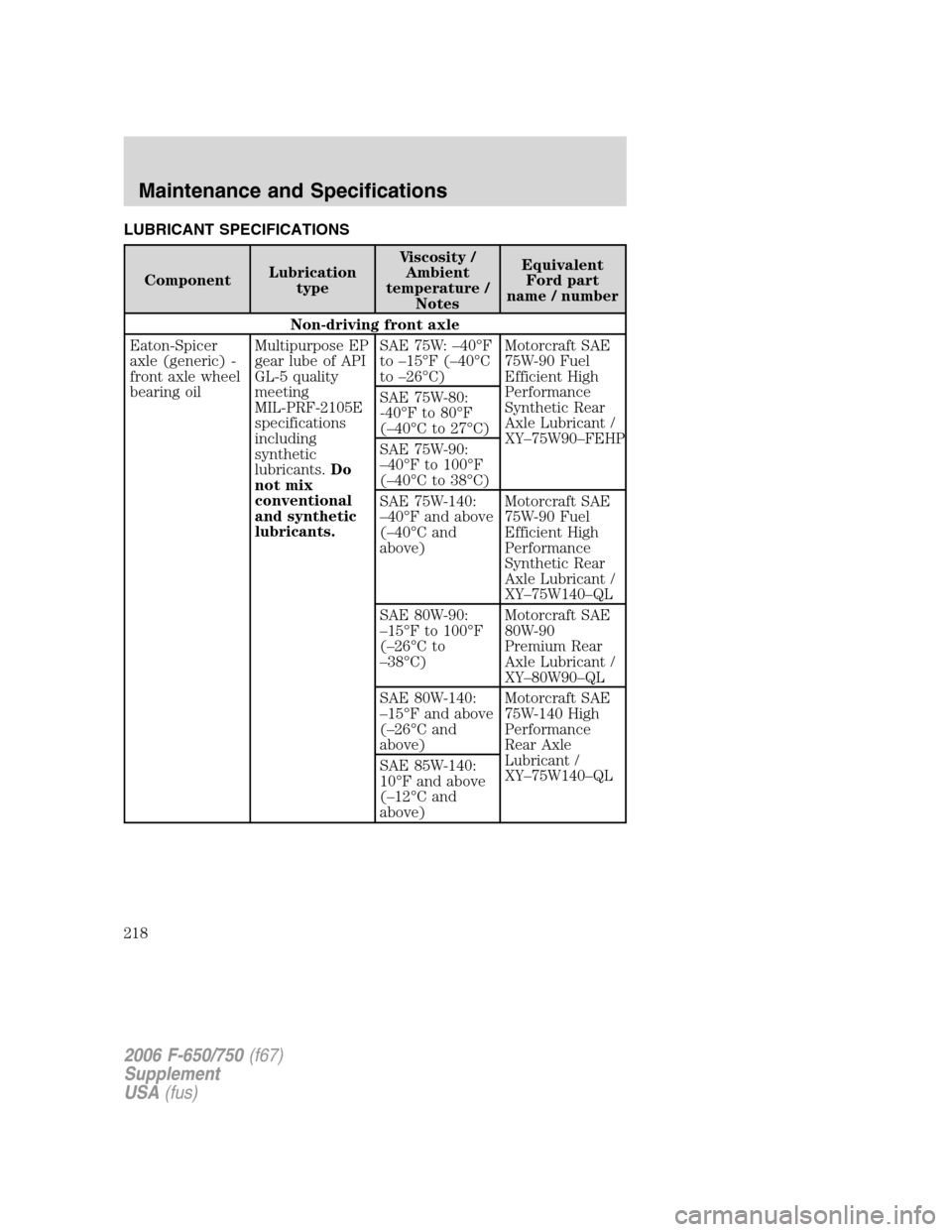
LUBRICANT SPECIFICATIONS
ComponentLubrication
typeViscosity /
Ambient
temperature /
NotesEquivalent
Ford part
name / number
Non-driving front axle
Eaton-Spicer
axle (generic) -
front axle wheel
bearing oilMultipurpose EP
gear lube of API
GL-5 quality
meeting
MIL-PRF-2105E
specifications
including
synthetic
lubricants.Do
not mix
conventional
and synthetic
lubricants.SAE 75W: –40°F
to –15°F (–40°C
to –26°C)Motorcraft SAE
75W-90 Fuel
Efficient High
Performance
Synthetic Rear
Axle Lubricant /
XY–75W90–FEHP SAE 75W-80:
-40°F to 80°F
(–40°C to 27°C)
SAE 75W-90:
–40°F to 100°F
(–40°C to 38°C)
SAE 75W-140:
–40°F and above
(–40°C and
above)Motorcraft SAE
75W-90 Fuel
Efficient High
Performance
Synthetic Rear
Axle Lubricant /
XY–75W140–QL
SAE 80W-90:
–15°F to 100°F
(–26°C to
–38°C)Motorcraft SAE
80W-90
Premium Rear
Axle Lubricant /
XY–80W90–QL
SAE 80W-140:
–15°F and above
(–26°C and
above)Motorcraft SAE
75W-140 High
Performance
Rear Axle
Lubricant /
XY–75W140–QL SAE 85W-140:
10°F and above
(–12°C and
above)
2006 F-650/750(f67)
Supplement
USA(fus)
Maintenance and Specifications
218
Page 219 of 272
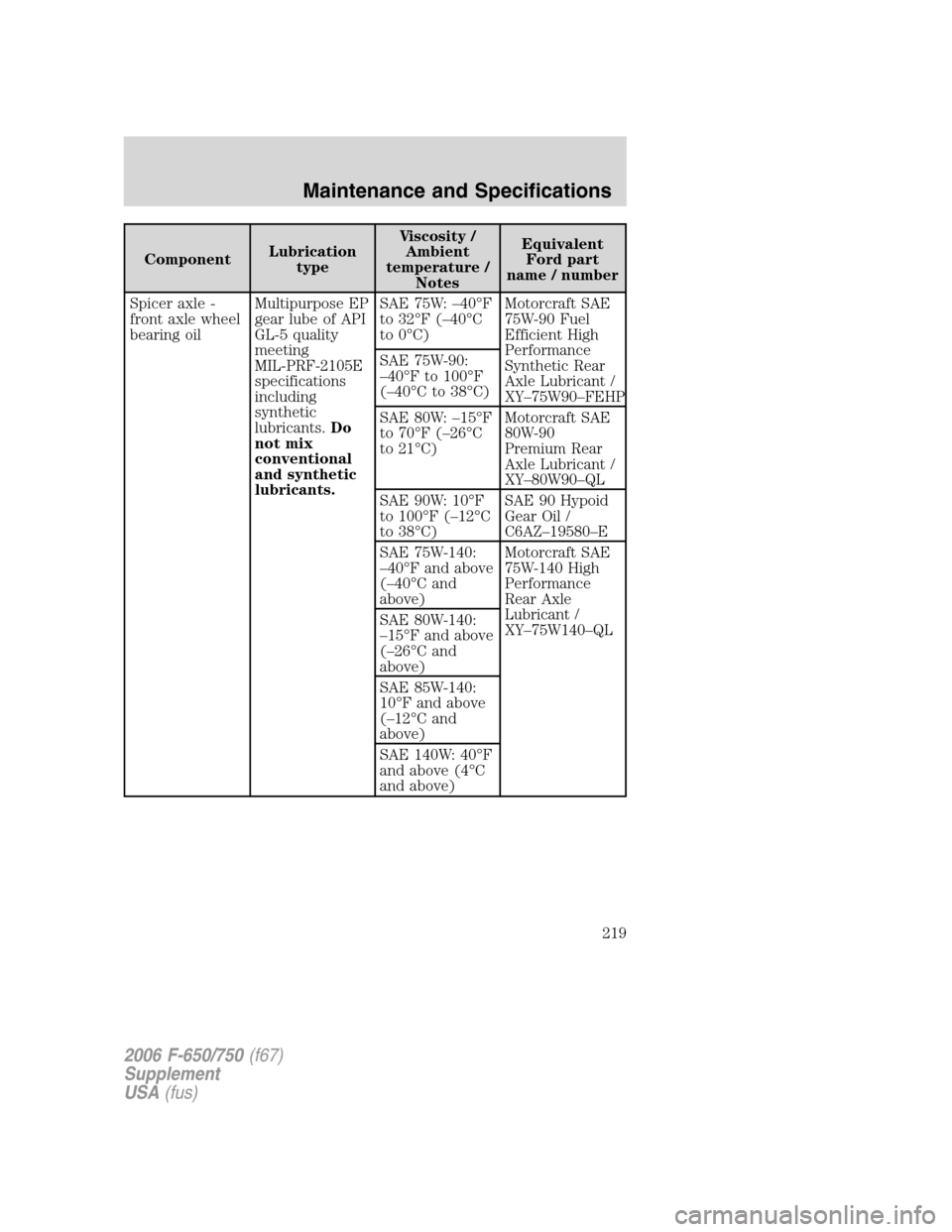
ComponentLubrication
typeViscosity /
Ambient
temperature /
NotesEquivalent
Ford part
name / number
Spicer axle -
front axle wheel
bearing oilMultipurpose EP
gear lube of API
GL-5 quality
meeting
MIL-PRF-2105E
specifications
including
synthetic
lubricants.Do
not mix
conventional
and synthetic
lubricants.SAE 75W: –40°F
to 32°F (–40°C
to 0°C)Motorcraft SAE
75W-90 Fuel
Efficient High
Performance
Synthetic Rear
Axle Lubricant /
XY–75W90–FEHP SAE 75W-90:
–40°F to 100°F
(–40°C to 38°C)
SAE 80W: –15°F
to 70°F (–26°C
to 21°C)Motorcraft SAE
80W-90
Premium Rear
Axle Lubricant /
XY–80W90–QL
SAE 90W: 10°F
to 100°F (–12°C
to 38°C)SAE 90 Hypoid
Gear Oil /
C6AZ–19580–E
SAE 75W-140:
–40°F and above
(–40°C and
above)Motorcraft SAE
75W-140 High
Performance
Rear Axle
Lubricant /
XY–75W140–QL SAE 80W-140:
–15°F and above
(–26°C and
above)
SAE 85W-140:
10°F and above
(–12°C and
above)
SAE 140W: 40°F
and above (4°C
and above)
2006 F-650/750(f67)
Supplement
USA(fus)
Maintenance and Specifications
219
Page 220 of 272
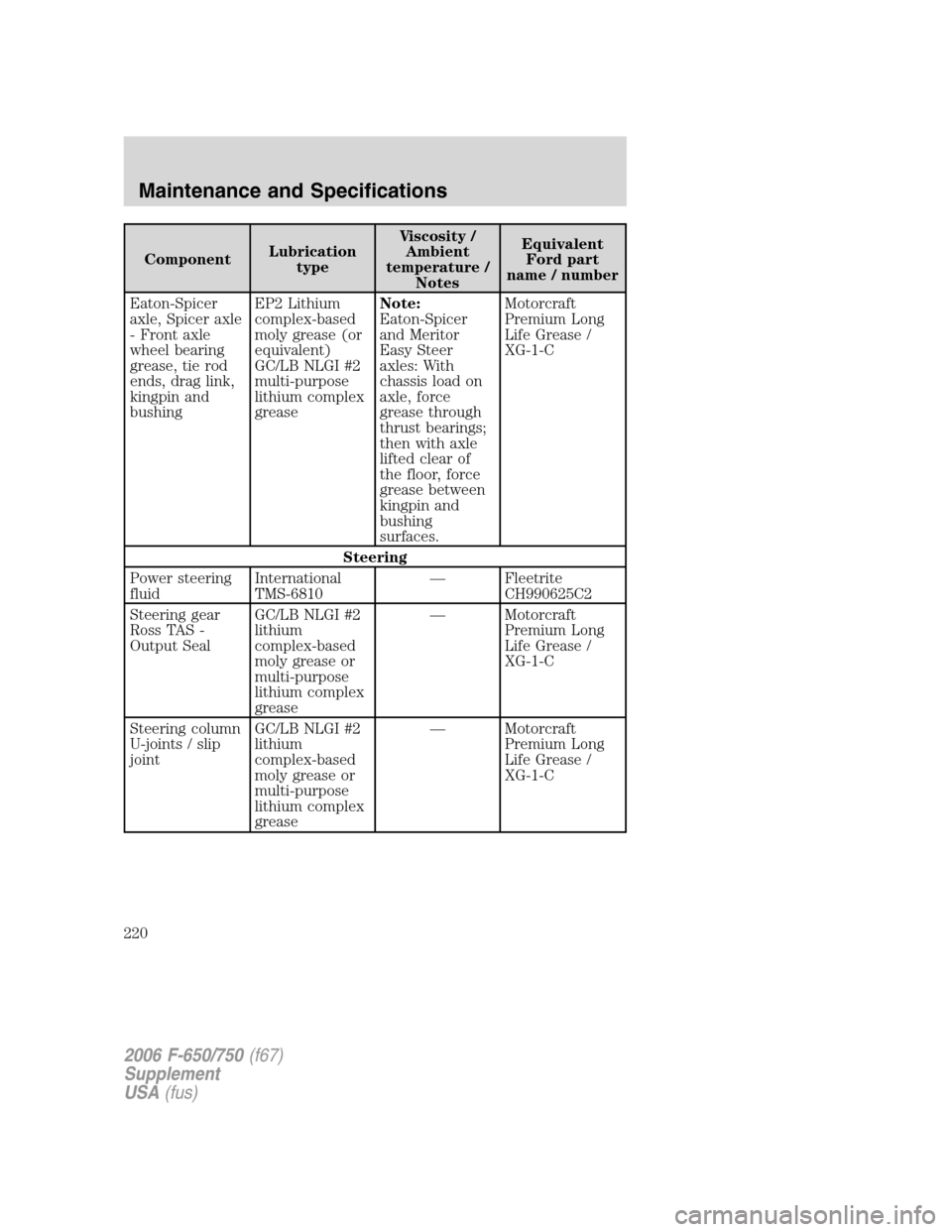
ComponentLubrication
typeViscosity /
Ambient
temperature /
NotesEquivalent
Ford part
name / number
Eaton-Spicer
axle, Spicer axle
- Front axle
wheel bearing
grease, tie rod
ends, drag link,
kingpin and
bushingEP2 Lithium
complex-based
moly grease (or
equivalent)
GC/LB NLGI #2
multi-purpose
lithium complex
greaseNote:
Eaton-Spicer
and Meritor
Easy Steer
axles: With
chassis load on
axle, force
grease through
thrust bearings;
then with axle
lifted clear of
the floor, force
grease between
kingpin and
bushing
surfaces.Motorcraft
Premium Long
Life Grease /
XG-1-C
Steering
Power steering
fluidInternational
TMS-6810— Fleetrite
CH990625C2
Steering gear
Ross TAS -
Output SealGC/LB NLGI #2
lithium
complex-based
moly grease or
multi-purpose
lithium complex
grease— Motorcraft
Premium Long
Life Grease /
XG-1-C
Steering column
U-joints / slip
jointGC/LB NLGI #2
lithium
complex-based
moly grease or
multi-purpose
lithium complex
grease— Motorcraft
Premium Long
Life Grease /
XG-1-C
2006 F-650/750(f67)
Supplement
USA(fus)
Maintenance and Specifications
220